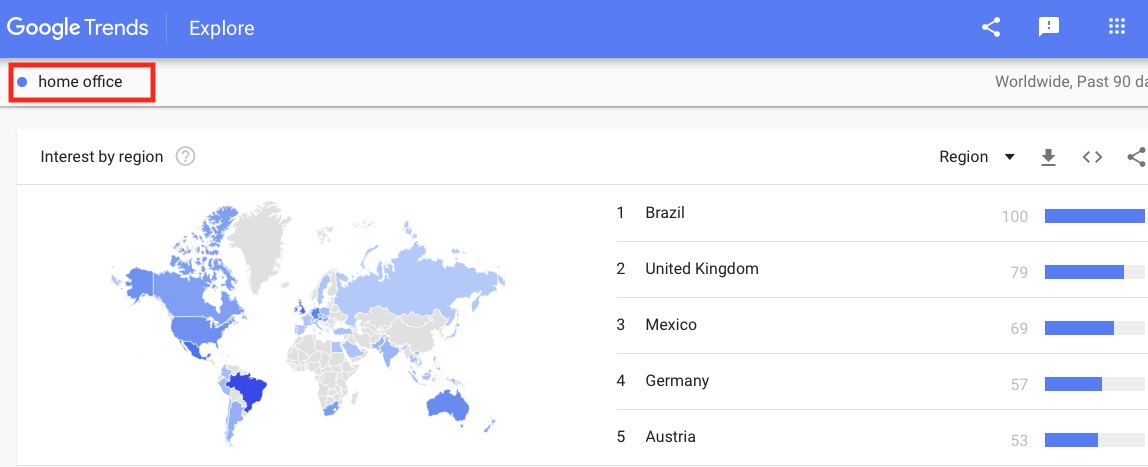Scaling an ecommerce business requires insights into the market, consumers, and products. In this post, I’ll address each aspect and how data can help.
The Market
An understanding of selling platforms, consumer trends, and competition is critical.
For platforms, can you expand your products and brand by selling on marketplaces such as Amazon, Walmart, or Etsy? An easy way to test is by searching for products that are similar to yours on those marketplaces to understand the competition and the potential profit margin. Another key data point is the size of the marketplace. Larger sites such as Amazon may provide more traffic but with a smaller profit margin. Also, foreign marketplaces can open new geographic regions.
Consumer trends can identify new products for your existing clients as well as new marketing opportunities. To generate new ideas, consider Google Trends. For example, “home office” is a popular term worldwide. Merchants could offer products related to a home office. Social media posts, product reviews, and competitor’s initiatives can also identify trends.

Google Trends can indicate product and marketing ideas. For example, the term “home office” is popular worldwide on Google Search in the previous 90 days.
For new marketing, conduct a small test on promising channels.
Finally, competitive analysis quarterly or even monthly can help you scale and save on marketing costs. Large competitors with huge marketing and store-optimization budgets are sources of inspiration. Marketing channels, creative, calls-to-action, personalization ideas — all have been tested by these competitors. Use those tests for your own purposes. Monitoring competitors’ product changes and discounts can indicate what is selling.
Key competitive metrics to track include marketing strategy, the number of times a company posts on Facebook, the number of emails deployed, a welcome promotion, discounted products, and site traffic. Competitor tools such as SimilarWeb (website stats), Google’s Ads for impression share of your competitors, and SpyFu for organic search rankings and ad spend. There are many such tools, but none are perfect in my experience.
Consumers
Understanding your target audience’s demographics, psychographics (opinions, values), and preferences is critical in finding new customers and expanding your product line. Obtain demographic and psychographic info from (i) third-party providers such as Experian and Melissa, (ii) marketing channels such as Google Ads or Facebook, (iii) Google Analytics, and (iv) qualitative analyses from social media or surveys. For data on preferences, customer-service interactions and reviews are a gold mine. Larger sites may require automated text mining for this.
Identifying high-value customers can help scale, too. Customer scoring — assigning a value to each buyer — can help. Examples are Recency, Frequency, and Monetary model or, also, lifetime value. Identifying even a few high-value customers can help define a perfect prospect for product testing or for lookalike marketing on Facebook and other platforms.
To expand geographically, consider Google Ads’ Keyword Planner to identify your products’ potential in new locations. This may require using Google Translate for keywords in non-English-speaking regions. Remember, too, that Google is not the primary search engine in all countries. For example, Yandex and Baidu are dominant in Russia and China, respectively.
Acquiring new customers may require a different marketing strategy. Online promotions may perform for consumers under age 45. But traditional channels, such as direct mail, could be better for the 65-plus age group. Prominently displaying a phone number and using larger text could help with older shoppers, too.
Products
Offering more products can help scale a business. Product ideas can be challenging as trends change and competitors surface. However, data can help.
First, look at Google’s auto-suggest options when searching for a category or item. The drop-down menu in Google’s search box contains the most common related phrases.

Google’s auto-suggest search options contain the most common related phrases, such as for “baby teething” in this example.
Another source of product ideas is your own site search. Look for items that visitors have searched for that you don’t carry. Reviews and customer support calls can also generate new-product ideas. Other sources include social media, trade magazines, feedback from suppliers, competitors’ products, and customer surveys.
Once you’ve listed product ideas, the next step is to understand the potential. Google’s Keyword Planner can indicate the competition (and cost) for keywords. Amazon, Walmart, and other marketplaces can show existing availability. Finally, understanding a potential selling price and profit margin is essential.
Finally, test new products before rolling them out across all channels. Test them on your site and on marketplaces. Test unique goods on Etsy. Offering pre-orders can generate capital and provide a test of an item’s viability.




